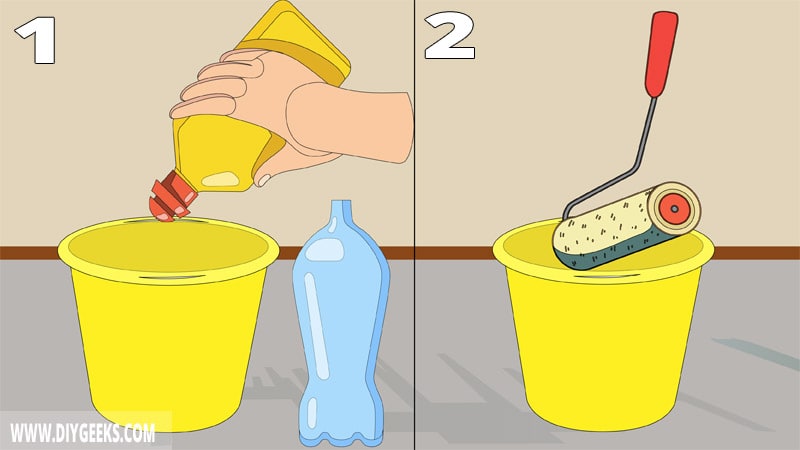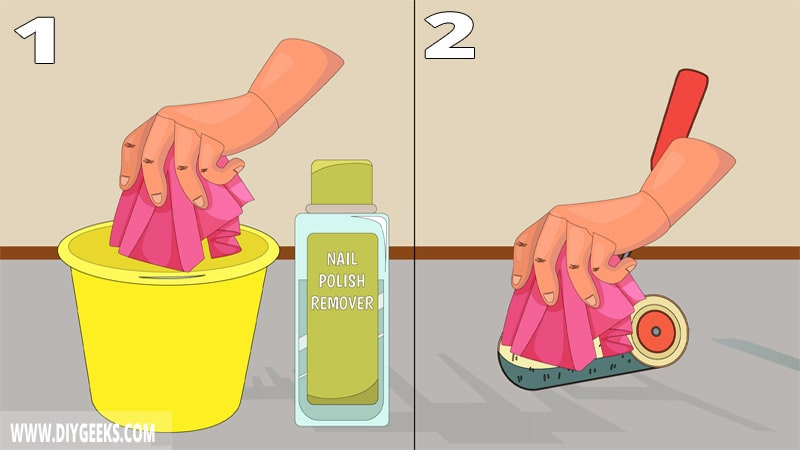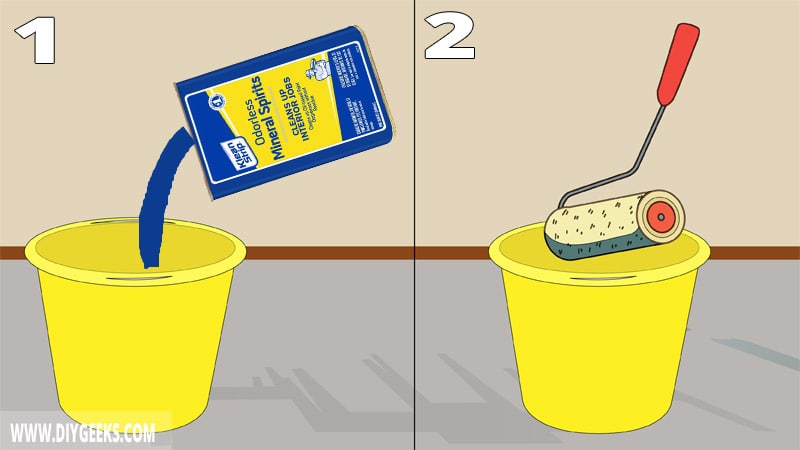Latex paint is water-based and gets stuck between paintbrush bristles. To clean latex paint from brushes, use a soapy mixture, acetone, or mineral spirits.
You don’t need to clean the brush between each coat as latex paint dries fast, so cleaning it is unnecessary.
Do You Need To Clean Latex Brushes Between Coats?
You don’t need to clean latex brushes between coats as the paint dries fast on the surface and cleaning the brush isn’t necessary. Instead, wrap and seal the paintbrush with plastic wrap, nylon bag, or aluminum foil and store it inside a fridge.
The wrap will keep the paint fresh and prevent it from drying in the paintbrush so you can re-use it once the coating on the surface dries. Ensure air doesn’t get inside the plastic wrap and seal it with nylon tape.
Since air can’t get inside of the plastic wrap, the latex paint solvent (water) can’t evaporate and the paint will remain wet for several hours (24 hours at best). This gives you the chance to reuse the same paintbrush without having to clean it between coats.
The paintbrush bristles will get deformed, hard, and rigid, and won’t apply the paint evenly if you clean the brush between coats too often. Clean the paintbrush only after you complete the whole painting project or if the time between coats is longer than 24 hours.
How to Clean Latex Paint from a Brush?
To clean latex paint from a brush, do the following things.
- Use a Soapy Mixture.
- Use Acetone.
- Use Mineral Spirits.
- Use Baking Soda.
- Use Rubbing Alcohol.
1. Use a Soapy Mixture

A soapy mixture (soap and water) will remove latex paint from paintbrushes and clean the bristles of the brush.
The tools you need for this project are listed below.
- Mild detergent or dish soap
- A bucket of warm water
- A small comb
- Rags
- A soft toothbrush
To remove latex paint off paintbrushes with soapy water, do the following things.
- Mix soap (or detergent) with warm water in a large bowl.
- Dip the latex paint into the mixture (in the bowl).
- Use a soft toothbrush to scrub the bristles.
- Use the comb to stroke the bristles — the comb removes paint between tiny bristles.
- Wipe the paintbrush with a clean rag, and stroke the bristles again (with the comb).
- If there’s leftover paint, repeat the steps.
- Rinse the brush with warm water and let it dry.
Tip: Don’t use detergents with bleach or corrosive substances, as it can damage the brush.
2. Use Acetone

Acetone will remove latex paint from brushes as it’s a paint remover and contains alcohol in its formula. Acetone softens the paint making scraping easier.
Simply, dip the paintbrush into a bowl filled with acetone until the paint is dissolved, and use a soft brush to remove the leftover paint.
The tools you need for this project are listed below.
- A bottle of acetone
- Rags
- A comb
- A soft toothbrush
- Rags
To remove latex paint off brushes with acetone, do the following things.
- Wipe excess paint off the paintbrush with a rag — this reduces the amount of paint acetone has to dissolve.
- Pour acetone into a clean bowl and soak a rag into it.
- Use the dampened rag to wipe the brush. Optionally, you can also pour some acetone into the brush.
- Wait 5-10 minutes.
- Use a toothbrush to scrub the bristles; this helps acetone get between them.
- Comb out the leftover paint.
- Rinse the brush with warm water and shake it to remove excess moisture.
- Leave it to dry.
Tip: If the latex paint has hardened, soak it in acetone for 5 minutes.
3. Use Mineral Spirits

Mineral spirits will remove latex paint from paintbrushes as it’s a petroleum-based solvent.
The tools you need for this project are listed below.
- Mineral spirits
- A comb
- A bowl of warm water
Here is a guide for this method:
- Rinse the brush with warm water — this softens the latex paint, so mineral spirits can work better.
- Pour mineral spirits into a clean bowl.
- Dip the brush in the mineral spirits bowl and wait 5-10 minutes.
- Take out the paintbrush and wipe it down with a clean rag.
- Repeat steps #3-4 until the paint is gone.
- Rinse the paintbrush with warm water.
- Leave it to dry.
- After it dries, store it properly, so it doesn’t accumulate dust.
Cleaning your latex paintbrush too frequently will damage the bristles and cause them to separate and turn spiky as they are exposed to harsh solvents, such as mineral spirits or acetone. When this happens, you can’t use them to apply paint anymore.
4. Baking Soda
Baking soda is an alkaline-based solvent that will dissolve wet and dry water-based paints. It’s also safe to use on brushes as it won’t deform them.
To do so:
- Mix a few spoons of baking soda with hot water
- Soak the brush into the mixture for 10 or 20 minutes if the paint is dry.
- Stroke the bristles with a plastic comb.
- Wipe the brush with warm water and leave it to dry.
5. Rubbing Alcohol
Rubbing or denatured alcohol is a natural paint-remover that can dissolve and remove water-based paints.
To use it:
- Douse a clean rag with the solvent.
- Use the dampened rag to wipe the latex off the brush.
- If the paint has dried, soak the brush in a bowl filled with rubbing alcohol for 5 minutes.
- Use a plastic comb to stroke the bristles.
- Rinse it with clean water and leave it to dry.
But, that’s not all. Check here all the things that dissolve latex paint.
How Many Times Can You Clean a Latex Paintbrush?
You can clean a latex paintbrush as often as possible if you use cleaning methods that don’t damage the bristles. If the bristles aren’t affected or damaged, the brush will continue to apply the paint evenly for several months (or a year).
However, the number of times you can clean it depends on the quality of the brush. For instance, low-quality and inferior brushes will get damaged faster than high-quality brushes. So, to increase the time you can clean it, use a high-quality brush with strong bristles.
On average, you must change your paintbrush every 6 months if you use it frequently. But, if you are an occasional painter, you can use the same brush for several years before changing it.


